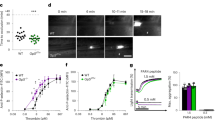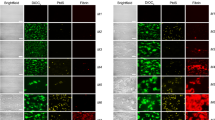Abstract
Platelet-dependent arterial thrombosis triggers most heart attacks and strokes. Because the coagulation protease thrombin is the most potent activator of platelets1, identification of the platelet receptors for thrombin is critical for understanding thrombosis and haemostasis. Protease-activated receptor-1 (PAR1) is important for activation of human platelets by thrombin2,3,4,5,6, but plays no apparent role in mouse platelet activation7,8,9. PAR3 is a thrombin receptor that is expressed in mouse megakaryocytes10. Here we report that thrombin responses in platelets from PAR3-deficient mice were markedly delayed and diminished but not absent. We have also identified PAR4, a new thrombin-activated receptor. PAR4 messenger RNA was detected in mouse megakaryocytes and a PAR4-activating peptide caused secretion and aggregation of PAR3-deficient mouse platelets. Thus PAR3 is necessary for normal thrombin responses in mouse platelets, but a second PAR4-mediated mechanism for thrombin signalling exists. Studies with PAR-activating peptides suggest that PAR4 also functions in human platelets, which implies that an analogous dual-receptor system also operates in humans. The identification of a two-receptor system for platelet activation by thrombin has important implications for the development of antithrombotic therapies.
This is a preview of subscription content, access via your institution
Access options
Subscribe to this journal
Receive 51 print issues and online access
$199.00 per year
only $3.90 per issue
Buy this article
- Purchase on Springer Link
- Instant access to full article PDF
Prices may be subject to local taxes which are calculated during checkout




Similar content being viewed by others
References
Davey, M. & Luscher, E. Actions of thrombin and other coagulant and proteolytic enzymes on blood platelets. Nature 216, 857–858 (1967).
Vu, T.-K. H., Hung, D. T., Wheaton, V. I. & Coughlin, S. R. Molecular cloning of a functional thrombin receptor reveals a novel proteolytic mechanism of receptor activation. Cell 64, 1057–1068 (1991).
Hung, D. T., Vu, T.-K. H., Wheaton, V. I., Ishii, K. & Coughlin, S. R. The cloned platelet thrombin receptor is necessary for thrombin-induced platelet activation. Blocking antiserum to the thrombin receptor's hirudin-like domain. J. Clin. Invest. 89, 1350–1353 (1992).
Brass, L. F. et al. Structure and function of the human platelet thrombin receptor. Studies using monoclonal antibodies directed against a defined domain within the receptor N terminus. J. Biol. Chem. 267, 13795–13798 (1992).
Vassallo, R. J., Kieber, E. T., Cichowski, K. & Brass, L. F. Structure-function relationships in the activation of platelet thrombin receptors by receptor-derived peptides. J. Biol. Chem. 267, 6081–6085 (1992).
Scarborough, R. M. et al. Tethered ligand agonist peptides. Structural requirements for thrombin receptor activation reveal mechanism of proteolytic unmasking of agonist function. J. Biol. Chem. 267, 13146–13149 (1992).
Connolly, T. M. et al. Species variability in platelet and other cellular responsiveness to thrombin receptor-derived peptides. Thromb. Hemost. 72, 627–633 (1994).
Derian, C. K., Santulli, R. J., Tomko, K. A., Haertlein, B. J. & Andrade-Gordon, P. Species differences in platelet responses to thrombin and SFLLRN. Receptor-mediated calcium mobilization and aggregation and regulation by protein kinases. Thromb. Res. 6, 505–519 (1995).
Connolly, A. J., Ishihara, H., Kahn, M. L., Farese, R. V. & Coughlin, S. R. Role of the thrombin receptor in development and evidence for a second receptor. Nature 381, 516–519 (1996).
Ishihara, H. et al. Protease-activated receptor 3 is a second thrombin receptor in humans. Nature 386, 502–506 (1997).
Novak, E. K. et al. Cocoa: a new mouse model for platelet storage pool deficiency. Br. J. Haematol. 69, 371–378 (1988).
Vu, T.-K. H., Wheaton, V. I., Hung, D. T. & Coughlin, S. R. Domains specifying thrombin-receptor interaction. Nature 353, 674–677 (1991).
Chen, J., Ishii, M., Wang, L., Ishii, K. & Coughlin, S. R. Thrombin receptor activation: confirmation of the intramolecular tethered liganding hypothesis and discovery of an alternative intermolecular liganding mode. J. Biol. Chem. 269, 16041–16045 (1994).
Zhong, C., Hayzer, D. J., Corson, M. A. & Runge, M. S. Molecular cloning of the rat vascular smooth muscle thrombin receptor. Evidence for in vitro regulation by basic fibroblast growth factor. J. Biol. Chem. 267, 16975–16979 (1992).
Ishii, K., Hein, L., Kobilka, B. & Coughlin, S. R. Kinetics of thrombin receptor cleavage on intact cells: relation to signalling. J. Biol. Chem. 268, 9780–9786 (1993).
Kettner, C. & Shaw, E. D-phe-pro-argCH2Cl: a selective affinity label for thrombin. Thromb. Res. 14, 969–973 (1979).
Shuman, M., Botney, M. & Fenton, J. I. Thrombin-induced platelet secretion. J. Clin. Invest. 63, 1211–1218 (1979).
Goodwin, C. A. et al. Thrombin receptor activating peptide does not stimulate platelet procoagulant activity. Biochem. Biophys. Res. Commun. 202, 321–327 (1994).
Kramer, R. M. et al. Differential activation of cytosolic phospholipase A2 (cPLA2) by thrombin and thrombin receptor agonist peptide in human platelets. Evidence for activation of cPLA2 independent of the mitogen-activated protein kinases ERK1/2. J. Biol. Chem. 270, 14816–14823 (1995).
Henriksen, R. A., Samokhin, G. P. & Tracy, P. B. Thrombin-induced thromboxane synthesis by human platelets. Properties of anion binding exosite I-independent receptor. Arterioscler. Thromb. Vasc. Biol. 17, 3519–3526 (1997).
Mortensen, R. in Current Protocols in Molecular Biology (ed. Ausubel, F. M.) 9.16.1 (Wiley, New York, (1993)).
Meiner, V. L. et al. Disruption of the acyl-CoA:cholesterol acyltransferase gene in mice: evidence suggesting multiple cholesterol esterification enzymes in mammals. Proc. Natl Acad. Sci. USA 93, 14041–14046 (1996).
Ishihara, H., Zeng, D., Connolly, A. J., Tam, C. & Coughlin, S. R. Antibodies to protease-activated receptor 3 inhibit activation of mouse platelets by thrombin. Blood 91, 4152–4157 (1998).
Williams, J. A., McChesney, D. J., Calayag, M. C., Lingappa, V. R. & Logsdon, C. D. Expression of receptors for cholecystokinin and other Ca2+-mobilizing hormones in Xenopus oocytes. Proc. Natl Acad. Sci. USA 85, 4939–4943 (1988).
Capecchi, M. R. Altering the genome by homologous recombination. Science 244, 1288–1292 (1989).
Liu, L., Vu, T.-K. H., Esmon, C. T. & Coughlin, S. R. The region of the thrombin receptor resembling hirudin binds to thrombin and alters enzyme specificity. J. Biol. Chem. 266, 16977–16980 (1991).
Mathews, I. I. et al. Crystallographic structures of thrombin complexed with thrombin receptor peptides: existence of expected and novel binding modes. Biochemistry 33, 3266–3279 (1994).
Xu, W. F. et al. Cloning and characterization of human protease-activated receptor 4. Proc. Natl Acad. Sci. USA 95, 6642–6646 (1998).
Acknowledgements
We thank T. Yu for blastocyst injection and H. Bourne for critical reading of this manuscript and S. E. Millar for assistance with figures.
Author information
Authors and Affiliations
Corresponding author
Rights and permissions
About this article
Cite this article
Kahn, M., Zheng, YW., Huang, W. et al. A dual thrombin receptor system for platelet activation. Nature 394, 690–694 (1998). https://doi.org/10.1038/29325
Received:
Accepted:
Issue Date:
DOI: https://doi.org/10.1038/29325
This article is cited by
-
Platelet glycoprotein V spatio-temporally controls fibrin formation
Nature Cardiovascular Research (2023)
-
Low dose rivaroxaban for the management of atherosclerotic cardiovascular disease
Journal of Thrombosis and Thrombolysis (2023)
-
Neurological Complications Associated with Hereditary Bleeding Disorders
Current Neurology and Neuroscience Reports (2023)
-
The GPIb-IX complex on platelets: insight into its novel physiological functions affecting immune surveillance, hepatic thrombopoietin generation, platelet clearance and its relevance for cancer development and metastasis
Experimental Hematology & Oncology (2022)
-
Complement factor D is linked to platelet activation in human and rodent sepsis
Intensive Care Medicine Experimental (2021)
Comments
By submitting a comment you agree to abide by our Terms and Community Guidelines. If you find something abusive or that does not comply with our terms or guidelines please flag it as inappropriate.



